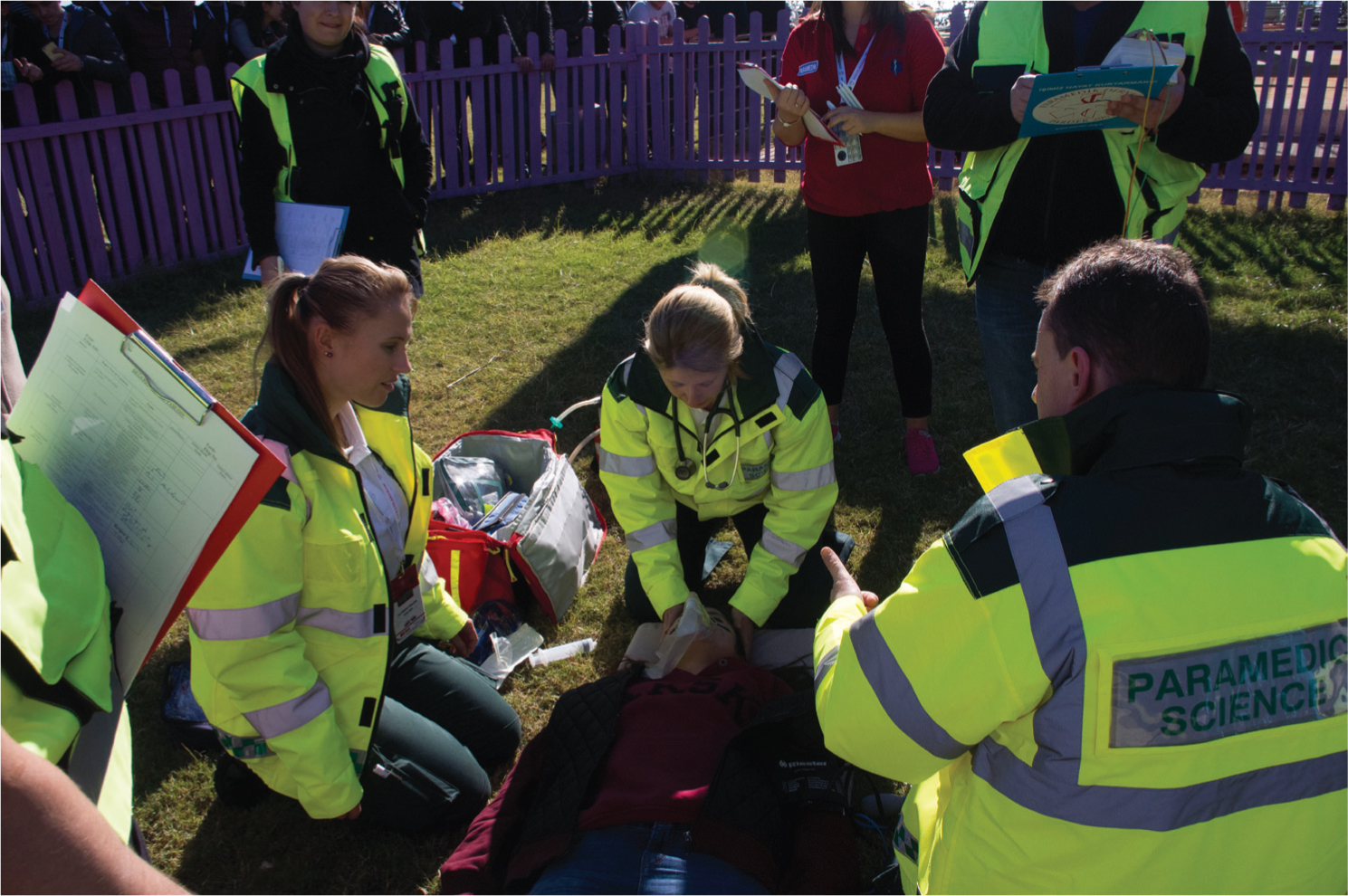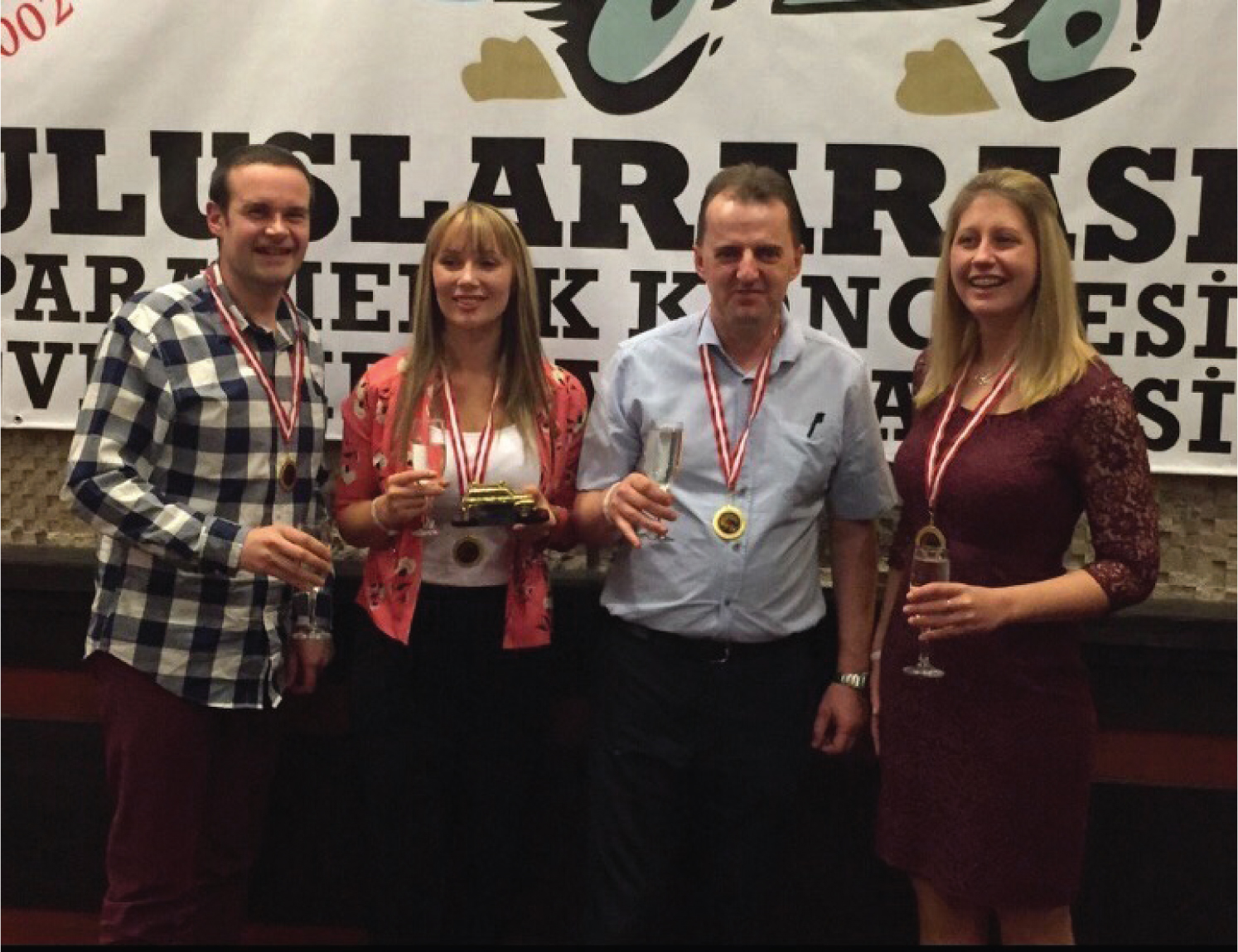In early December 2015, a team of Oxford Brookes Paramedic Science lecturers represented the university at the 13th Turkish International Paramedic Congress and Rally in Antalya, Turkey. This 4-day event featured a 3-day conference, during which Turkish national and international speakers presented about paramedic professional developments within their country, highlights on research and plans for future improvement. Alongside the conference was a 1-day international rally, where national and international teams competed against each other in a range of simulated scenarios.
International Paramedic Rally
The rally competition was held one day prior to the conference; it involved four clinical scenarios, during which international and Turkish teams’ practice was assessed during a competition to determine who was best. With 50 teams competing in the rally, it required a huge amount of organisation and lasted from early morning until late night. Each scenario was sited in an unusual part of the venue, where teams encountered simulated patients with a variety of moulage injuries. At each scenario a judging panel assessed the team's performance and awarded points based upon specific treatment aspects and overall management. There was also considerable interest from conference delegates and bystanders who independently judged the performance of each team.
It was thoroughly enjoyable to participate in the rally and each member of the team had an amazing experience. While there were four team members, using response equipment brought with us from England, only three people participated in each scenario. There were several people watching, including student paramedics from Turkey and even holiday makers at the hotel. Due to working commitments we were not able to practice as intensively as the Turkish teams, many of whom spent several hours preparing for the Rally.
As a Turkish language competition we needed an interpreter to provide translation into English; this did cause some challenges and disruption to the scenarios while we waited for information and the assessors attempted to understand our actions. Each scenario had several differences from our practice in England, for example, the defibrillators used had manual paddles which we were unfamiliar with and required use after a few minutes of familiarisation to their operation. For those of us in paramedic education, this lack of training and potential for dangerous use of live defibrillators seemed an opportunity for some improvements to be made. Adjusting rapidly to equipment that was different and unfamiliar for use during the rally posed another challenge, but added to the experience.

We started with the first scenario, a cardiac arrest on the beach. The initial information allowed us to determine that the patient had collapsed but no further details were provided. Following a brief period of resuscitation, the patient demonstrated a return of spontaneous circulation; the scenario had been designed with additional complexity, during our management it became apparent the patient was bradycardic, hypotensive, hypothermic and hypoglycaemic. The second scenario required management of a patient found responsive but lying next to a swimming pool. It became apparent she was suffering from a suspected supraventricular tachycardia but there was no 12-lead ECG available. This could not be reverted into a sinus rhythm with vagal stimulation or adenosine administration; she required sedation and cardioversion.
This provided an interesting insight into the scope of practice possessed by Turkish paramedics. While it is rare for Turkish paramedics to have completed a higher education degree, they are able to sedate and administer a wider range of drugs than Health and Care Professions Council-registered paramedics. The third scenario involved a patient suffering from traumatic injuries, having fallen on a building site from height. He remained responsive but confused, complained of neck pain and difficulty in breathing and had a compound tibia and fibular right leg fracture. This required decompression of a tension pneumothorax and movement onto an orthopaedic stretcher, before moving onto the final incident. The fourth scenario was a major incident caused by a bus crash requiring management of the scene and triage of several patients.

Participating in these scenarios provided an interesting opportunity to meet and discuss paramedic practice with Turkish and international colleagues. Following completion of the rally there was an award ceremony, as a team we were delighted to be awarded with individual medals and a trophy for being the best team for the cardiac arrest scenario.
Turkish pre-hospital services
The Republic of Turkey is a transcontinental country linking Europe with Asia and has a population of approximately 75.8 million people (United Nations, 2015). Its capital is Ankara, where over 10 million of its population live. Unlike the United Kingdom (UK), with an overall ageing population, Turkey's population tends to be younger and only 6% of the population are older than 64 years of age (Live Population, 2015).
This population variation affords Turkey a different provision of health care to that of the UK, based upon a different aetiology of cases seen. Focus is on pre-hospital treatment followed by transportation to a hospital. The Turkish healthcare system is administered by the Turkish Ministry for Health who control and direct overall operation of the country's ambulance response. Turkey uses a €340 million budget to maintain its country-wide ambulance provision. Further financial support comes from the National Social Security system, Social Aid and Solidarity trust and the traffic assurance foundation.
Turkey has an established emergency medical system (EMS) with its contemporary model originating in the early 2000s from a Franco-German model of emergency care. Here, doctors and nurses are the prime responders dispatched to emergency situations from around 600 ambulance stations. Recently, pre-hospital services have moved towards an increasingly structured model of standardised national access following an Anglo-American model of emergency care provision. Additionally, since 2005, supported by the Turkish Ministry for Health, emergency medical technician and paramedic roles have been developed. Supporting this change has been an expansion in the pre-hospital workforce, number of ambulance stations and a single point of access to EMS via the 112 call system.
Much like the UK, Turkish EMS systems have performance measured through a response time target. The expected response time for a rural setting that an ambulance is expected to arrive in is less than 30 minutes, while in non-rural settings it is expected to be less than 10 minutes. For life-threatening emergencies, the activation time for ambulances is up to 2 minutes. Each 112 call centre has a supervising physician and they make the decision about whether or not an ambulance will be dispatched, this means that the majority of 112 calls do not receive an ambulance response.
Currently, it is estimated that 30 000 paramedics work in Turkey, with over 9 000 trainees undertaking an associate programme at one of 95 universities offering paramedic development.
Turkey's paramedics work to national guidelines that are published by the Ministry for Health following European Resuscitation Council and American Heart Association protocols. Turkish paramedic practice is not autonomous and some interventions require permission from a supervising physician in the 112 call centre. The wages for Turkish paramedics are funded centrally by the Ministry of Health as these are above average and there are high-levels of employment—many people wish to become a paramedic. In some areas Turkish paramedics work a 24-hour shift pattern, meals and uniform are frequently provided, although sometimes individuals choose to replace issued equipment for items that are seen as more comfortable, e.g. safety boots for trainers.
There is a similar discussion around education in Turkish paramedics familiar to the UK. Current models of training for a Turkish paramedic follows a modular approach, undertaking a 40-day certificated course that consists of basic life support, advanced life support, trauma management, disaster medicine, driver training and ambulance teamwork. At the conference, Sinan Nural, chairman of the Turkish Paramedic Association, suggested that Turkey should move towards undergraduate education programmes with specific specialisation for its paramedics.
Similar to UK paramedics, it was proposed this would improve their patient assessment and management skills, and address areas of wider development such as enhanced critical decision-making ability. Mr Nural advocated for a more focused university approach to education and training so that the level of practice for paramedics reflects their education and experience within the paramedic role needed for the future healthcare system in Turkey. Furthermore, he suggested that ongoing education and development to strengthen the profession is needed to further establish paramedics as a profession.
It was of particular interest for many of the Turkish educators and paramedics in attendance to discover more about UK, Canadian and German approaches to paramedic development and education. We noticed that from our international colleagues that UK paramedic education direction, particularly the establishment of undergraduate pre-registration pathways and postgraduate specialist education, were seen as advanced in comparison to their experiences. There is no regulatory body for paramedics in Turkey, which was seen as moving Turkish paramedics’ development towards autonomous practitioners and professionalisation.
There was concern expressed at the conference of injury experienced by Turkish paramedics, one particular source reported injuries resulting from unsecured loose equipment. Most ambulances are converted commercial vehicles, with few being specifically designed to store equipment, as a result it can be damaged or result in a preventable injury occurring.
It is clear paramedics in Turkey face many of the educational, professional and developmental issues experienced by UK counterparts. There is a demand from Turkey to collaborate with professional organisations and higher education institutes to develop the Turkish paramedic workforce. These are areas in which the College of Paramedics and UK universities could use their experience to support such development.
Conclusions
Attendance at the 13th Turkish International Paramedic Congress and Rally provided an opportunity to share ideas, collaborate and learn about other cultures of paramedic practice. It provided a fantastic opportunity to jointly share experiences and learn from one another to help paramedics develop internationally as a profession. We would recommend attendance at the event, which will provide a fantastic learning and cultural experience, for any paramedic practising in the UK.
Inspired by this event, Oxford Brookes is hosting the first Student Paramedic International Rally of Emergency Simulations (SPIRES) in June this year. This event will bring student paramedics together from across the globe to share their experiences, compete in a competition rally, as well as discuss current issues in practice. Sharing of ideas in this is essential for the progression of the profession, in addition to developing further opportunities for students to undertake placements abroad, improve their knowledge and skillset, and introduce innovative ideas. For more information pleasesearch for the ‘Student Paramedic International Rally of Emergency Simulations 2016’.

